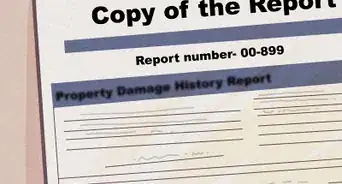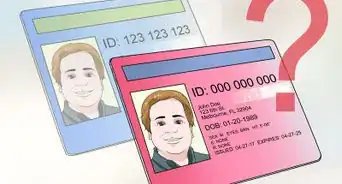This article was co-authored by Clinton M. Sandvick, JD, PhD. Clinton M. Sandvick worked as a civil litigator in California for over 7 years. He received his JD from the University of Wisconsin-Madison in 1998 and his PhD in American History from the University of Oregon in 2013.
There are 8 references cited in this article, which can be found at the bottom of the page.
This article has been viewed 26,116 times.
Before you report a robbery, you should try to write down a description of the robber. Robbery is a violent crime and you may be emotionally shaken after the event. However, it is important to report the robbery to the police as soon as possible. If cash or valuables were stolen from your home or business, then you may need to file an insurance claim.
Steps
Preparing to Report
-
1Confirm you did not grant consent. Robbery is defined as the taking of something valuable from your control or custody through the use of force or threat of force.[1] Accordingly, you were not robbed if you let someone borrow something which they haven’t returned.
- If someone refuses to return an item, even after you ask for it back, then you have also been the victim of a crime (theft) and should report it.
-
2Note the robber’s appearance. Try to remember what he or she looks like so that you can tell the police. If possible, you should write down important details while they are fresh in your memory. Try to note the following: [2]
- the robber’s approximate age
- the robber’s gender and race
- the robber’s height and weight
- physical details, such as eye color or hair color
- distinctive characteristics, such as facial deformities or tattoos, or an unusual way of talking or walking
- the robber’s clothing
- whether the robber had a weapon
Advertisement -
3Stay safe. You shouldn’t do anything that would provoke the robber to escalate the use of force. If you can’t safely flee from the robber, then remember the following:
- Always stay calm. Calmness will reduce the likelihood that the robber will harm you. Furthermore, you will remember details better if you remain calm. Take several deep breaths and try to stay in control of your emotions.
- Act submissive. Do whatever the robber says and don’t unnecessarily ask question. Always make sure the robber can see your hands. If you need to move your hands to where the robber can’t see them, then get permission
- Don’t stare at the robber’s face—this will signal that you are trying to remember his or her appearance. Instead, cast short glances in the robber’s direction.
-
4Leave your home as you found it. If you are robbed in your home (or your car or office), leave the crime scene so that you don’t contaminate it. The robber could have left behind evidence, which the police could gather. You shouldn’t touch anything.
- Instead, you can step outside your house or business and make a phone call to the police. Wait for them to show up at the scene before going back inside. You don’t want to spoil any evidence.
Reporting the Robbery
-
1Call the police. To report the robbery, call your local police department. If you do not know the number, then contact the telephone operator and ask to be connected.
- In the United States you can call 9-1-1 for all emergencies.[3] If you are not in immediate danger, then you can call the non-emergency number.
- If your phone was stolen, go to the nearest business and tell them you were robbed. Asked if you can use their phone or if they can call for you.
-
2Answer follow-up questions. You may be asked to come into the police station to fill out a report or to meet with a detective. Take all evidence you have (including your witness description) to the police station. Write down the name of any officer you speak to.[4]
- Be sure to only share copies of any evidence, as you may need the original at a later date.
- Don’t forget to get a copy of the police report. You will need it in case you file an insurance claim.[5]
-
3Pick the robber out of a lineup. If the police have a suspect, they may invite you to the station to view a lineup. At the lineup, the suspect along with other fillers will stand before you for your observation.[6]
- The police will begin the lineup by telling you that the suspect may or may not be in the lineup. Then you will be asked to identify anyone who you think looks like the suspect. If none look familiar to you, then say so.
- Sometimes, the police will show you a series of photographs in a “photo lineup.” They will then ask you to look at the photographs and identify anyone who looks like the suspect.[7]
-
4Document your total loss. Once you feel safe, you should go through your home or business and document everything that has been taken from you. Write up a list of items.[8]
- Also try to find any receipts or credit card statements related to stolen items. Also find any related photographs or owner manuals.[9]
-
5Report the robbery to an insurer. If you were robbed inside your home or business, you may be covered by insurance. You should take out your policy and review it. If you think you are covered, then do not wait to report the robbery. Most insurance companies require that you report a loss within 48-72 hours.[10]
-
6Complete a claims form. To make a formal claim to your insurance company, you will have to complete the company’s claims form. [11] Each form differs, depending on the insurer, but you will typically be asked for:[12]
- the place you purchased the item and when you purchased it
- the brand and model
- the cost
References
- ↑ https://www.fbi.gov/about-us/cjis/ucr/crime-in-the-u.s/2012/crime-in-the-u.s.-2012/violent-crime/robbery
- ↑ http://www.depts.ttu.edu/opmanual/OP76.08A.pdf
- ↑ https://www.portlandoregon.gov/police/article/31555
- ↑ http://www.nolo.com/legal-encyclopedia/renters-insurance-claims-damaged-stolen-property.html
- ↑ http://www.nolo.com/legal-encyclopedia/renters-insurance-claims-damaged-stolen-property.html
- ↑ http://blogs.findlaw.com/blotter/2014/06/what-happens-in-a-police-lineup.html
- ↑ http://blogs.findlaw.com/blotter/2014/06/what-happens-in-a-police-lineup.html
- ↑ https://www.travelers.com/claims/theft-vandalism-claims.aspx
- ↑ https://www.travelers.com/claims/theft-vandalism-claims.aspx
- ↑ http://www.nolo.com/legal-encyclopedia/renters-insurance-claims-damaged-stolen-property.html
- ↑ http://www.nolo.com/legal-encyclopedia/renters-insurance-claims-damaged-stolen-property.html
- ↑ https://homesite.com/insurance-resources/home-insurance-articles/what-to-expect-when-filing-a-theft-claim.htm





































































